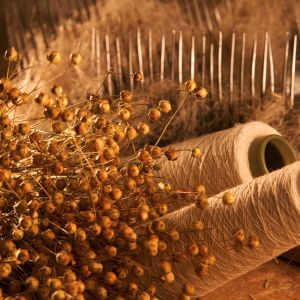Industrial Uses
In use for ages, flax’s natural quality and superior performance make it an important part of many fine products we use today. Flax is environmentally friendly. It makes coatings and floorings friendlier, concretes tougher, and fibre products stronger.

Linseed oil products help manufacturers maintain good air quality, providing modern solutions to protect and beautify our world. Manufacturers today are turning to new linseed oil products such as Dilulin™ in paint products, and Archer #1™ , a co-adhesive in popular fibreboard. These linseed products replace some solvents and petroleum-based chemicals in the products’ formulations, thereby combatting air pollution. In many places, environmental regulations call for the reduction of dangerous volatile organic compounds (VOCs) which solvents spew into the air, interacting with sunshine and creating smog.
Linoleum flooring, the most durable sheet flooring material, is an attractive flooring for a new century. An all-natural, enviro-friendly product, linoleum contains about 30 per cent linseed oil. Not only is it beautiful and long-lasting, it is gentle on the environment. As linoleum flooring is completely biodegradable, it decomposes when discarded. With modern colours and performance, linoleum has become the flooring of choice in public buildings and private dwellings throughout the world. Artist-designed inlays are becoming increasingly popular in linoleum flooring because the material lends itself so readily to cutting by water-jet cutting techniques.
Linseed oil, derived from flax, is a major ingredient in many fine oil paints, varnishes and stains. However, because coatings’ labels seldom carry ingredient lists, the linseed oil content may not be visible on these products. Nevertheless, linseed oil preserves and beautifies, providing superior protection on wooden surfaces, from decks to marine products.
Raw or Boiled Linseed Oil?
Raw linseed oil dries very slowly, compared to boiled linseed oil which is simply raw oil with chemical accelerators, called driers, added. Because boiled linseed oil has a faster drying time, people generally prefer it for most uses.
Linoleum was invented in England in 1863 by Frederick Walton who coined the name linoleum from the Latin name, linum , which means flax, and oleum , which means oil. Later in the century, Michael Nairn, a flooring manufacturer in Kirkcaldy, Scotland perfected the flooring, introducing qualities such as inlaid patterning — a feature seen today.
Linoleum is a flooring that is manufactured by oxidizing linseed oil to form a thick mixture called linoleum cement. The cement is cooled and mixed with pine resin, and wood flour to form sheets on a jute backing. The term, linoleum is often used incorrectly to describe any sheet flooring, when in fact flooring can be made from other materials such as polyvinyl chloride.

The First Choice for the Environment
Linoleum flooring is based on a century-old recipe that features linseed oil (the oil in flax). While exhibiting all the craftsmanship of old, present-day linoleum flooring is produced in ultra-modern facilities in the European Union. For environmental reasons, linoleum is often architects’ first choice for flooring.
Linoleum shows superiority where environment plays a large part in the choice of flooring; you’ll find linoleum in prestigious educational facilities, in hospitals and government buildings all over the world.
Architects choose linoleum because it satisfies clients’ needs to be environmentally responsible. In life cycle assessments of products that deal with factors like toxicity and the depletion of natural resources, linoleum’s environmental “footprint” is small. As a result, linoleum brands, such as the Artoleum™ and Marmoleum™ made by Forbo, have earned environmental certification from the countries of Austria, Australia, Germany, the Netherlands, New Zealand and Scandinavia.
Natural ingredients
Three factors make linoleum friendly to the environment: linoleum is made of sustainable, natural ingredients; it lasts a very long time; and it disposes well.
Environmental tests on linoleum have been conducted, production processes mechanized, and factories modernized. Through it all, linseed oil from Canadian flax remains the main ingredient. Linseed oil, hardened onto the canvas of sailcloth, was the prototype for the first linoleum flooring in the 1800s and linseed oil remains as the key ingredient of new formulations for linoleum. This ingredient has not changed over time because of linseed oil’s unique properties. Linseed hardens upon exposure to the air, making it a natural coating material. Linoleum floors last for 20 years or more.
Because flax is an annual crop of the western Canadian prairies, the source of linseed oil will never be depleted. The same cannot be said for finite oil resources from which other types of sheet flooring are manufactured.
The natural ingredients in linoleum are:
- Linseed oil (from flax)
- Rosins, tapped from pine trees
- Wood flour, ground from forest timbers
- Limestone
- Natural pigments
All the materials are layered onto a natural jute backing.
Easy Disposal
When discarded, linoleum flooring decomposes well in landfill sites. Linoleum is biodegradable and does not release harmful gases or toxins into the air as it breaks down.
Rooted in the past, manufactured in “high-tech” production environments, and designed for the future— linoleum is an ideal flooring for today’s world.
Plant fibre is gaining attention as an attractive plentiful source of natural fibre. For generations, short flax fibre from the stems of Canadian oilseed flax has been processed for use in making fine bond papers. Recently, manufacturers have developed new technology to use this strong, short fibre in other fibrous products such as car-door panels, plant pots and retaining mats.
Tough and strong, flax fibre use is increasing in many products. State-of-the-art technology developed for flax ensures flax fibre a fine future!
Currently, flax straw, fibre, and shive are underutilized, with the exception of a few niche markets. The transformation of flax straw into advanced bio-based materials used in industrial applications presents a significant opportunity for FC2015 and for Canada.
Flax straw and shive can move beyond their lowly status as a waste product. In North America, flax straw is processed primarily for application in the pulp and paper industry. With the rise of the bio-economy, other uses of flax straw are being researched. Promising end uses include animal bedding, horticultural mulch, particleboard, insulation board, loose-fill insulation, plastic composite filler, and heating fuel.
Linseed Oil Preserves Concrete, Naturally
Linseed oil effectively preserves concrete surfaces, naturally. A coating prevents destructive water and salts from penetrating concrete. It stabilizes the smooth concrete surfaces in parking structures, bridges and concrete buildings, and prevents the breakdown of reinforcing steel. A testing program completed at the University of Hong Kong in 1996, proved conclusively that linseed oil-based preservatives extend and enhance the life of concrete.
Flax Council of Canada
The Flax Council of Canada is a national organization which promotes Canadian flax and flax products for nutritional and industrial uses in domestic and international markets.